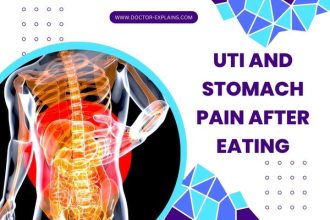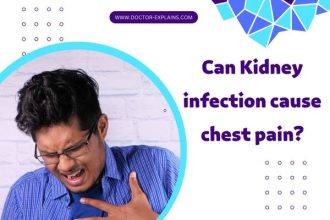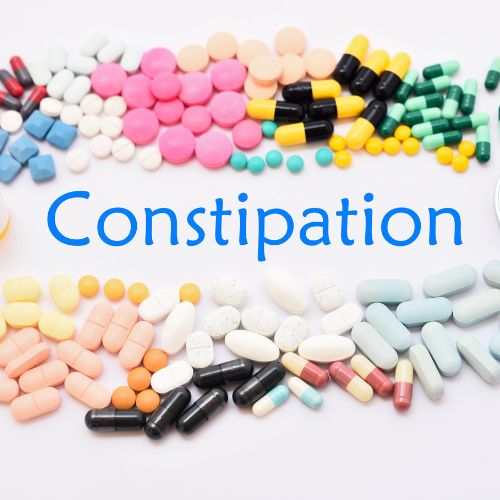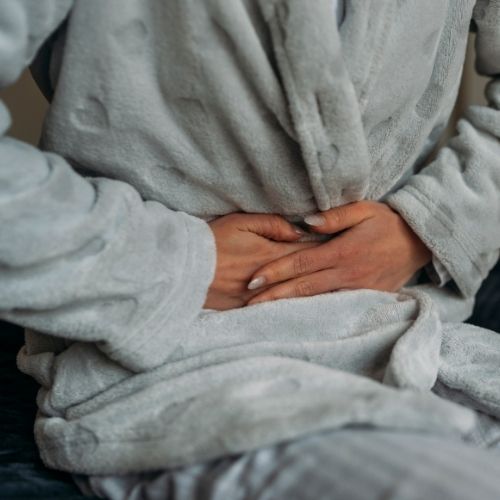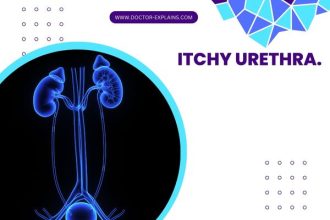Key facts about stomach pain after emptying the bladder:
The possible causes of stomach pain after emptying the bladder include UTIs, interstitial cystitis, constipation, and how to differentiate between urinary tract and gastrointestinal pain.
Key facts:
- Stomach pain after emptying the bladder can be caused by various factors, including UTIs, interstitial cystitis, bladder stones, IBS, abdominal muscle strains, and constipation.
- Diagnosis requires a detailed medical history, physical examination, and diagnostic tests.
- Severe or persistent pain that does not improve with home care requires consultation with a healthcare professional.
- Blood in urine or stool, unexplained weight loss or loss of appetite, high fever or chills, vomiting or inability to keep fluids down, and pain accompanied by other serious symptoms such as shortness of breath or chest pain also require consultation with a healthcare professional.
Causes of stomach pain after emptying the bladder
1. Urinary Tract Infection (UTI)
Prevalence: UTI is a very common condition, especially among women. About 50 to 60% of women will get at least one UTI in their life, making it one of the most common causes of pain or discomfort in the lower stomach area after urination.
Symptoms:
- Burning sensation during urination
- Frequent urge to urinate
- Cloudy or strong-smelling urine
- Lower abdominal pain after urination.
- A feeling of incomplete bladder emptying.
- Fever and chills (in severe cases)
Diagnosis of UTI:
Urinary tract infection is typically diagnosed by the presence of pyuria in urine cells, plus a positive culture test for bacteria and/or positive leucocyte esterase test in urine analysis.
Treatment:
Antibiotics are typically prescribed for UTIs based on the type of bacteria causing the infection. It is crucial to complete the full course of antibiotics to ensure the infection is eradicated. Drinking plenty of water and using over-the-counter pain relievers can help alleviate symptoms.
2. Interstitial Cystitis
Prevalence:
Affects between 3 and 8 million women and 1 to 4 million men in the United States.
Symptoms:
- Chronic pelvic pain
- Frequent urination (more than 8 times a day)
- Urgency to urinate
- Pain during urination or after emptying the bladder
- Pain during sexual intercourse
How is it diagnosed:
Diagnosis is based on symptoms, ruling out other conditions, and sometimes a bladder examination. A healthcare professional may use cystoscopy to visualize the bladder lining and identify any abnormalities.
Treatment:
There is no cure for interstitial cystitis, but treatment options can help manage symptoms. These include medications (such as oral drugs, bladder instillations, or nerve stimulation), physical therapy, and lifestyle changes (dietary modifications, stress management, and quitting smoking).
3. Urinary Bladder Stones
Prevalence:
Bladder stones are relatively uncommon but more prevalent in men than women.
Symptoms:
- Pain in the lower abdomen
- Blood in the urine
- Frequent urination
- Pain during urination
- Difficulty urinating
- Urinary tract infections
How is it diagnosed:
Imaging tests such as X-rays, ultrasounds, or CT scans can identify bladder stones. Sometimes, a healthcare professional may perform a cystoscopy to examine the bladder directly.
Treatment:
It includes flushing out small stones by increasing fluid intake, breaking larger stones with a laser or other energy source (lithotripsy), or surgically removing them. Treatment also involves addressing the underlying cause of stone formation, such as bladder outlet obstruction or chronic urinary tract infections.
4. Irritable Bowel Syndrome (IBS)
Prevalence:
Affects 10-15% of the global population, with a higher prevalence in women (women are 2.5 more likely to have IBS than men) (reference).
Symptoms:
- Abdominal pain or cramping, often relieved by a bowel movement
- Bloating and gas
- Diarrhea, constipation, or alternating between the two
- Mucus in the stool
How is it diagnosed:
Diagnosis is based on symptoms and ruling out other conditions. A healthcare professional may use the Rome IV criteria, which require the presence of abdominal pain for at least one day per week in the last 3 months, associated with a change in bowel habits.
Treatment:
Treatment focuses on managing symptoms through diet (such as a low FODMAP diet), medications (antispasmodics, laxatives, or anti-diarrheal agents), and stress management techniques (such as cognitive-behavioral therapy or relaxation exercises).
5. Abdominal Muscle Strain
- Prevalence: Abdominal muscle strains are relatively common, especially among athletes and those engaging in strenuous physical activities.
- Symptoms:
- Pain or tenderness in the abdominal area, often aggravated by movement
- Swelling or bruising
- Limited range of motion or difficulty performing certain activities
- How is it diagnosed: Diagnosis is typically based on a physical examination and patient history. In some cases, imaging tests like ultrasound or MRI may be ordered to assess the severity of the injury.
- Treatment: Rest, ice, compression, and elevation (RICE) are recommended for muscle strain treatment. Over-the-counter pain relievers and anti-inflammatory medications can help alleviate pain and swelling. A healthcare professional may recommend physical therapy or a rehabilitation program in more severe cases.
- How common: abdominal muscle strains are sort of frequent, particularly among athletes and those engaging in exhausting natural movements.
- Symptoms:
- Pain or soreness in the stomach region, often exacerbated by movement
- swelling or bruising
- limited range of motion, or hardship performing certain activities
- How is it diagnosed: Diagnosing is typically grounded on a corporal examination and patient tale. In some cases, imaging tests like ultrasound or MRI may be prescribed to assess the severity of the harm.
- Treatment: Rest, ice, compression, and elevation (RICE) are commended for sinew strain management. Over-the-counter pain relievers and anti-inflammatory medications can aid in alleviating agony and tumescence. A healthcare master may commend physical therapy or a renewal program in more stern cases.
In summary, abdominal muscle strains, particularly among athletes, are reasonably frequent and can cause stomach pain after urination.
6. Constipation
- Prevalence: Affects an estimated 16% of adults worldwide, with a higher prevalence in women and older adults.
- Symptoms:
- Infrequent bowel movements (fewer than three per week)
- Hard or lumpy stools
- Straining during bowel movements
- A feeling of incomplete evacuation or blockage at the rectum
- Abdominal bloating or discomfort
- How is it diagnosed: Diagnosis is based on symptoms, bowel movement patterns, and a physical examination. A healthcare professional may also order tests such as blood tests, abdominal X-rays, or a colonoscopy to rule out other conditions.
- Treatment: Treatment options include increasing fiber intake, staying hydrated, engaging in regular physical activity, and using over-the-counter laxatives. Sometimes, a healthcare professional may prescribe stronger medications or recommend biofeedback therapy.
7. Others
- Other bladder conditions: Overactive bladder, bladder cancer, or cystitis can cause pain or discomfort after emptying the bladder.
- Pelvic Inflammatory Disease (PID): Infection of the female reproductive organs can cause lower abdominal pain, especially in sexually active women. Symptoms include fever, abnormal vaginal discharge, and pain during intercourse.
- Other gastrointestinal disorders: Inflammatory bowel disease (Crohn’s disease or ulcerative colitis), colon cancer, or diverticulitis can all cause abdominal pain and may be aggravated by bladder emptying.
What are the differences between urinary tract pain and gastrointestinal pain?
The table below illustrates how to differentiate between the origin of pain (whether from the urinary or gastrointestinal tract).
| Characteristic | Gastrointestinal Pain | Urinary Tract Pain |
|---|---|---|
| Pain Location | generalized or lower abdomen (intestinal pain), or upper abdomen (stomach, pancreas, gallbladder, or esophageal pain). | Lower abdomen, pelvis, lower back, or side |
| Related Symptoms | Bloating, gas, diarrhea, heartburn, or constipation. | Frequent urination, urgency, dysuria |
| Pain Character | Cramping (as IBS, gastroenteritis), sharp (as pancreatitis)., gnawing (such as gastritis), or burning. | Burning pain or discomfort (continuous) in the pelvic area or flank pain. |
| Onset of Pain | Often related to food intake or bowel movements | Often related to urination |
| Pain Duration | Can be short-lived or chronic | It can be acute or chronic |
| Aggravating Factors | Certain foods, stress, or medication side effects. | Holding urine, sexual activity, urination. |
| Alleviating Factors | Antacids, dietary changes, bowel movements, or antispasmodics. | Emptying the bladder, antibiotics, or analgesics. |
| Associated Conditions | GERD, IBS, gastritis, food intolerance | UTI, kidney stones, interstitial cystitis |
Diagnosis of the cause of pain
A healthcare professional will take a detailed medical history, perform a physical examination, and may order imaging tests, laboratory tests, or other diagnostic procedures to pinpoint the cause of pain. The specific tests and procedures will depend on the suspected cause and the patient’s symptoms.
When to see a doctor?
- Severe or persistent pain that does not improve with home care
- Blood in urine or stool
- Unexplained weight loss or loss of appetite
- High fever or chills
- Vomiting or inability to keep fluids down
- Pain accompanied by other serious symptoms, such as shortness of breath or chest pain
FAQs
How do I stop stomach pain after eating?
- Eat smaller, more frequent meals instead of large meals
- Avoid trigger foods, such as spicy, fatty, or gas-producing foods
- Stay hydrated by drinking water or non-caffeinated beverages
- Try over-the-counter antacids or gas-relief medications to alleviate discomfort
- Practice relaxation techniques, such as deep breathing or meditation, to reduce stress-related stomach pain
What causes lower abdominal pain after urination or pooping?
Possible causes of lower abdominal pain after urination or bowel movements include UTIs, interstitial cystitis, constipation, IBS, muscle strain, or other bladder and gastrointestinal conditions.
What causes lower stomach pain after bladder emptying?
Common causes of lower stomach pain after bladder emptying include UTIs, interstitial cystitis, and bladder stones. Other bladder conditions or gastrointestinal disorders may also cause pain or discomfort.
Can the bowels put pressure on the bladder?
Yes, constipation or other gastrointestinal issues can pressure the bladder, potentially causing pain or discomfort. A full bowel can compress the bladder, making it difficult to empty completely and increasing the risk of urinary tract infections. Addressing constipation or other gastrointestinal problems can help alleviate bladder pressure and associated symptoms.
